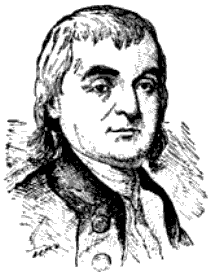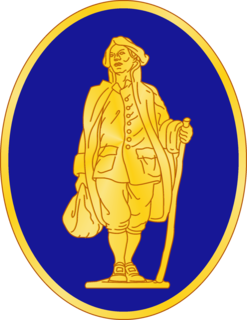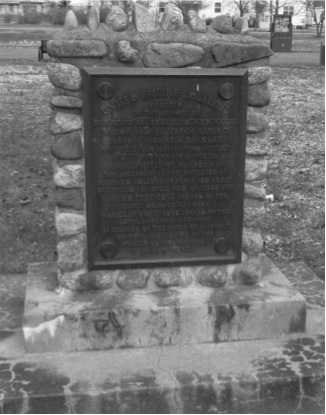
Sir Frederick Philipse Robinson, GCB was a soldier who fought for Britain during the American War of Independence. His father, Colonel Beverley Robinson, was a Virginian who moved to New York, marrying a wealthy heiress of the Philipse family with Dutch and Bohemian ancestry, Susanna Philipse. Frederick was born in the Hudson Highlands on the family estate in the Philipse Patent, today's Putnam County, New York, in September 1763.

The British Legion was the name of a British provincial regiment established during the American Revolutionary War, composed of British Loyalist American infantry and dragoons. It was colloquially known as Tarleton's Raiders, the Green Devils, the Green Horse, and the Green Dragoons, after the British officer who led most of its day-to-day activities, Lieutenant Colonel Banastre Tarleton, and the green uniform coats of its officers. "Legion" was an 18th-century term for a military unit the size of a regiment, but consisting of infantry and cavalry, or infantry, cavalry, and artillery, all under one command, to make it more flexible for scouting or irregular operations than a regiment, which consisted of infantry or cavalry alone.

The 84th Regiment of Foot was a British regiment in the American Revolutionary War that was raised to defend present day Ontario, Quebec and Atlantic Canada from the constant land and sea attacks by American Revolutionaries. The 84th Regiment was also involved in offensive action in the Thirteen Colonies; including North Carolina, South Carolina, Georgia, Virginia and what is now Maine, as well as raids upon Lake Champlain and the Mohawk Valley. The regiment consisted of 2,000 men in twenty companies. The 84th Regiment was raised from Scottish soldiers who had served in the Seven Years' War and stayed in North America. As a result, the 84th Regiment had one of the oldest and most experienced officer corps of any regiment in North America. The Scottish Highland regiments were a key element of the British Army in the American Revolution. The 84th Regiment was clothed, armed and accoutred the same as the Black Watch, with Lieutenant Colonel Allan Maclean commanding the first battalion and Major General John Small of Strathardle commanding the second. The two Battalions operated independently of each other and saw little action together.
The Hillsborough District Brigade of militia was an administrative division of the North Carolina militia established on May 4, 1776. Brigadier General Thomas Person was the first commander. Companies from the eight regiments of the brigade were engaged in 55 known battles and skirmishes in North Carolina, South Carolina, and Georgia during the American Revolutionary War. It was active until the end of the war.
The King's Rangers, also known as the King's American Rangers, was a Loyalist provincial ranger unit raised in Nova Scotia for service during the American Revolutionary War.

Beverley Robinson, was a soldier and wealthy colonist of the Province of New York. Robinson married Susanna Philipse, heiress to a significant share of the roughly 250 square miles (650 km2) Highland Patent on the lower Hudson River in the Province of New York. With the onset of the American Revolutionary War, he sought to remain uninvolved, but in 1777 formed the Loyal American Regiment, which proved a very active Loyalist force in that conflict.

The Queen's Rangers, also known as the Queen's American Rangers, and later Simcoe's Rangers, were a Loyalist military unit of the American Revolutionary War. Formed in 1776, they were named for Queen Charlotte, consort of George III. The Queen's Rangers served as a light corps in the tradition of British rangers during the Seven Years' War, operating on the flanks and in advance of Crown forces, manning outposts, conducting patrols, and carrying out reconnaissance and raiding operations.
The Volunteers of Ireland, also known as the 2nd American Regiment and the 105th Regiment of Foot, was a British Provincial military unit, raised for Loyalist service, during the American Revolutionary War, which was later added to the British regular army. The Volunteers of Ireland should not be confused, with the contemporaneous Irish Volunteers an autonomous militia that supported the Irish Patriot Party, in the 1770s and 1780s.
The New York Volunteers, also known as the New York Companies and 1st Dutchess County Company, was a British Loyalist Provincial regiment, which served with the British Army, during American Revolutionary War. Eventually, the New York Volunteers became the 3rd American Regiment, after being place on American establishment.
McAlpin's Corps, also known as McAlpin's Corps of Royalists and the American Volunteers, referred to either of two loyalist units in the British Army, in British Canada, commanded by Major Daniel McAlpin, during the American Revolutionary War. In most instances, the name described the American Volunteers, a corps of American Loyalists, who served in the 1777 Burgoyne Expedition, of the Saratoga Campaign. The term was also used, at times, to refer to a 'battalion' put under the command of McAlpin, in 1779, formed from the remnants of General Burgoyne's several loyalist corps, including the "American Volunteers", the King's Loyal Americans, the Queen's Loyal Rangers, and Adams' Rangers.

This is a list of auxiliary regiments or units formed by the British in individual colonies of the British Empire. In some colonies, the units were led by officers seconded from the British Army. Especially in the case of units that recruited non-whites, even in colonies where the officers were primarily colonials, commissions were generally restricted to whites until after the Second World War. Non-white colonials, as well as non-whites from Britain itself served primarily in the other ranks. Although militias operating on the same principle as the militia in England and Wales were established in many colonies during the 17th and 18th Centuries, from the 19th Century onwards colonial units were mostly voluntary, and supplied a reserve force either to be called up in war time to reinforce regular British Army garrisons for home defence, or in some cases were entirely responsible for home defence. Many units, however, took part in active campaigns outside of the role of home defence in various conflicts the British Empire was involved in, including the two world wars.

Associators were members of 17th- and 18th-century volunteer military associations in the British American thirteen colonies and British Colony of Canada. These were more commonly known as Maryland Protestant, Pennsylvania, and American Patriot and British Loyalist colonial militias. But unlike militias, the associator military volunteers were exempt from regular mandatory military service. Other names used to describe associators were "Associations", "Associated", "Refugees", "Volunteers", and "Partisans".
The Royal Nova Scotia Volunteer Regiment, also known as the Loyal Regiment of Nova Scotia Volunteers and Loyal Nova Scotia Volunteers, from 1775-1780, the Royal Regiment of Nova Scotia Volunteers, from 1780-1783, and the Royal Nova Scotia Volunteer Regiment and Nova Scotia Volunteers, was a British Loyalist provincial battalion, of infantry, raised in 1775, to defend British interests, in the colony of Nova Scotia. The unit was commanded by Col. Francis Legge, until replaced by Col. John Parr in 1782. The Royal NS Volunteers never saw combat, but did play an important role in the defense of the colony of Nova Scotia, in the later years, of the American Revolution.

The King's Orange Rangers, also known as the Corps of King's Orange Rangers, were a British Loyalist battalion, raised in 1776 to defend British interests in Orange County, Province of New York and generally in and around the New York colony, although they saw most of their service in the Province of Nova Scotia. The battalion's commander was Lieutenant Colonel John Bayard. The Rangers had an undistinguished military record, through most of its existence, and saw very limited combat, mostly against Patriot privateers, but did play an important role in the defence of the colony of Nova Scotia in the later years of the American Revolution. The King's Orange Rangers are especially remembered for their role in the defence of Liverpool, in the Nova Scotia colony.

The Province of Nova Scotia was heavily involved in the American Revolutionary War (1776–1783). At that time, Nova Scotia also included present-day New Brunswick until that colony was created in 1784. The Revolution had a significant impact on shaping Nova Scotia, "almost the 14th American Colony". At the beginning, there was ambivalence in Nova Scotia over whether the colony should join the Americans in the war against Britain. Largely as a result of American privateer raids on Nova Scotia villages, as the war continued, the population of Nova Scotia solidified their support for the British. Nova Scotians were also influenced to remain loyal to Britain by the presence of British military units, judicial prosecution by the Nova Scotia Governors and the efforts of Reverend Henry Alline.
North Carolina state troops in the American Revolution were the initial military units created in a transition from the Province of North Carolina under British rule to independence from British rule. Most units did not last long as such and were either transferred to the Continental Army or state militia instead.
The Royal North Carolina Regiment was a provincial corps of Loyalists from the Province of North Carolina during the American Revolution. Provincial corps were regiments with both British and Loyalist forces.










